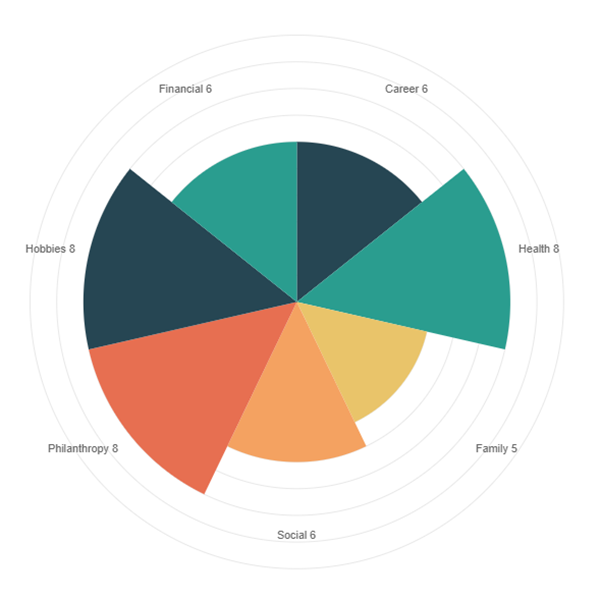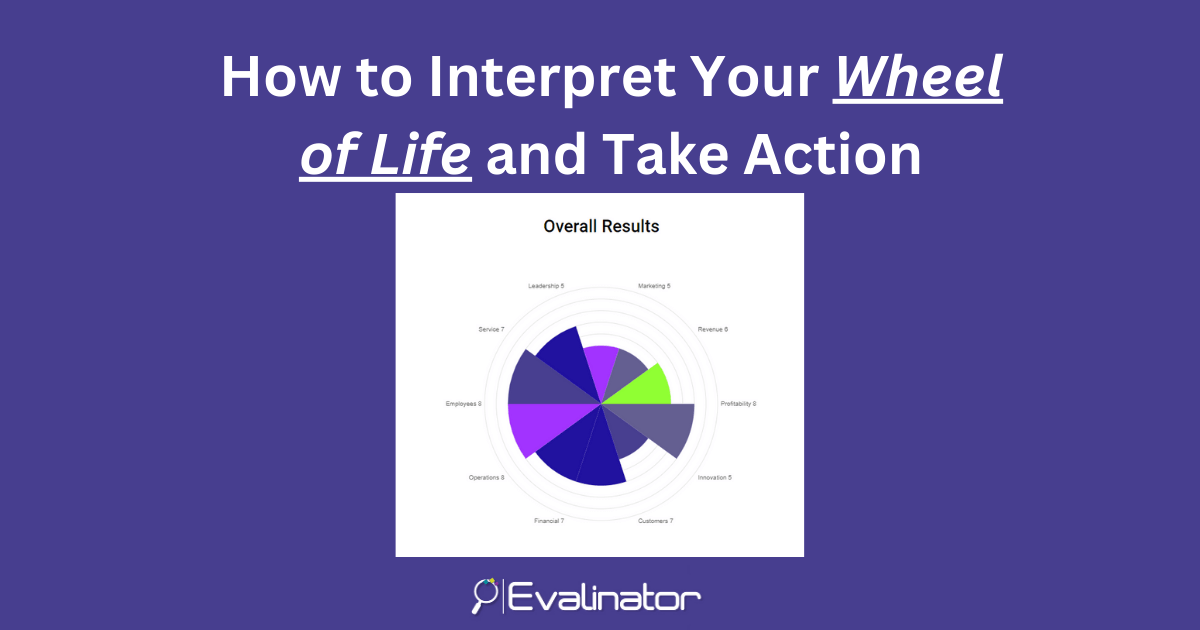Interpreting the Wheel of Life: From Insight to Action
In this article, we’ll show you how to interpret a wheel of life, set goals, and take meaningful action.
The Wheel of Life is a powerful guiding compass in our quest for fulfillment and balance.
It offers a great opportunity to self-reflect and provides a birds eye view the various facets of our life.
From career to relationships, health to personal development, this simple tool helps us assess, prioritize, and enhance different areas of our lives.
Purpose of the Wheel of Life
The Wheel of Life serves as an instrument aimed at:
- Increasing self-awareness
- Setting meaningful goals
- Achieving holistic balance
Its primary objectives include:
- Identifying Areas of Focus: By breaking down life into distinct categories or spokes, the Wheel of Life prompts us to evaluate each aspect individually. It highlights areas that require attention and improvement.Example: Someone may rate their satisfaction in the “Health” spoke low while they rate high in financial stability. This may indicate a need to prioritize exercise, nutrition, or self-care practices.
- Setting Clear Goals: By rating satisfaction levels in each category, respondents gain clarity on their priorities and aspirations. This lays the groundwork for setting achievable goals.Example: A person who rates their satisfaction low in the “Career” spoke may set a goal to acquire new skills or seek opportunities for advancement.
- Working through confusing goals: Sometimes we set and work on a lot of goals at the same time. But it’s very difficult to make progress on many fronts at the same time. By visualizing the wheel’s segments, individuals can assess the distribution of their time, energy, and resources across different areas. That way they can prioritize how they want to achieve their goals. It helps them get equilibrium and maintain focus.Example: Someone who consistently neglects the “Recreation” spoke may realize the importance of incorporating leisure activities into their routine for overall well-being.
- Adapting to Change: The Wheel of Life is a dynamic tool that evolves with us. It reflects changes in our priorities, circumstances, and aspirations over time. So be sure to take the assessment at least once every year. If you feel you are not following your goals, then take it even more often and plan accordingly.Example: Following a significant life event like a career transition or relationship change, revisiting the Wheel of Life can help realign goals and recalibrate focus areas.
Popular Categories/Spokes of the Wheel
The spokes of the Wheel of Life typically encompass key dimensions of human experience.
Note: These below are typical categories. But you could customize a wheel for any area that can be broken down into sub categories, such as career, leadership, health etc. See here for examples.
 Common categories in a holistic wheel include:
Common categories in a holistic wheel include:
- Career: Reflects satisfaction and fulfillment in one’s professional endeavors, including job satisfaction, growth opportunities, and work-life balance.
- Relationships: Encompasses personal and social connections, such as family, friendships, romantic partnerships, and community involvement.
- Health: Gauges physical, mental, and emotional well-being, encompassing aspects like exercise, nutrition, sleep, stress management, and overall vitality.
- Finances: Evaluates financial stability, security, and management practices, including income, savings, debt, budgeting, and financial goals.
- Personal Development: Focuses on continuous learning, growth, and self-improvement, encompassing areas like education, skill development, hobbies, and self-reflection.
- Recreation/Leisure: Considers activities that bring joy, relaxation, and fulfillment outside of work or obligations, such as hobbies, travel, and creative pursuits.
- Contribution/Service: Reflects engagement in meaningful causes, volunteerism, and making a positive impact on others or the community.
- Spirituality: Explores one’s connection to higher meaning, purpose, values, and beliefs, encompassing religious practices, meditation, mindfulness, or philosophical exploration.
Interpreting the Wheel of Life
Once the Wheel of Life is completed, interpreting the results involves more than just examining individual satisfaction ratings.
It’s also about understanding the interconnectedness and interdependence of different life domains.
For instance, a low rating in the “Career” spoke may not only affect financial stability but also spill over into relationships or personal well-being due to increased stress or dissatisfaction.
Similarly, neglecting health may hinder both career performance and the ability to enjoy leisure activities fully.
By recognizing these relationships and dependencies, individuals can strategize holistic approaches to improvement, addressing root causes rather than symptoms.
For instance, enhancing time management skills may improve work-life balance (Career spoke), thereby freeing up time for recreation and personal development.
Moreover, interpreting the Wheel of Life involves acknowledging that balance doesn’t mean equal attention to every spoke.
Instead, it’s about aligning priorities with personal values and aspirations, recognizing that different seasons of life may warrant different emphases.
Here are some simple yet effective techniques to help you interpret your Wheel of Life and make good progress:
- Brainstorming with Your Coach: Sit down with your life coach or a trusted friend to explore potential solutions and strategies for improving low-rated areas. Brainstorming together can spark creativity and uncover new perspectives.Example: If your career satisfaction is low, you and your coach might brainstorm ways to enhance job satisfaction, such as seeking out new challenges, networking with colleagues, or exploring career advancement opportunities.
- Future Visualization: Imagine yourself at age 75, looking back on your life. What achievements and experiences would bring you the greatest sense of fulfillment and satisfaction? Use this visualization exercise to identify long-term goals and priorities.Example: Visualizing yourself at age 75, you may realize that nurturing meaningful relationships with friends or extended family, and maintaining good health are essential for long-term happiness. This insight can guide you in prioritizing these areas in your life.
- Goal Setting: Translate your insights from the Wheel of Life into actionable goals. Break down larger goals into smaller, manageable steps and set specific deadlines for achieving them. This approach helps you stay focused and motivated.Example: If your health spoke is rated low, set a goal to exercise for at least 30 minutes three times a week and cook healthy meals at home instead of eating out. By breaking down your health improvement goals into smaller steps, they become more achievable.
- Seeking Feedback: Don’t hesitate to seek feedback from others who know you well, such as friends, family members, or colleagues. They may offer valuable insights and perspectives that you hadn’t considered.Example: You might ask your partner for feedback on your relationship dynamics and how you can strengthen your connection. Their input could highlight areas for improvement and provide guidance on nurturing a healthier and more fulfilling relationship.
- Experimentation: Be open to trying out new approaches and strategies to see what works best for you. Treat the process of self-improvement as an ongoing experiment, learning from both successes and setbacks along the way.Example: If you’re exploring ways to improve your personal development, experiment with different hobbies, online courses, or self-help books to see which resonate most with you and contribute positively to your growth.
- Journaling: Take time to reflect on your Wheel of Life results through journaling. Write down your thoughts, feelings, and insights about each category, as well as any ideas or strategies that come to mind for improvement.Example: Use your journal to explore the underlying reasons for low satisfaction in certain areas, such as past experiences, limiting beliefs, or external factors. This self-reflection can provide valuable clarity and direction for growth.
- Accountability Partnerships: Partner with a friend, family member, or colleague who shares similar goals or is also working on self-improvement. Hold each other accountable for progress, provide support and encouragement, and celebrate successes together.Example: Create a weekly check-in with your accountability partner to review your progress towards your goals and discuss any challenges or obstacles you’ve encountered. Knowing that someone else is rooting for your success can boost motivation and commitment.
- Visualization Board: Create a visualization board or collage that represents your ideal life based on the insights gained from the Wheel of Life. Include images, words, and symbols that inspire and motivate you towards your goals in each area of your life.Example: If one of your goals is to travel more and explore new destinations, include pictures of your dream travel destinations. Also include inspiring quotes about adventure and exploration, and symbols that represent freedom and adventure. Display your visualization board in a prominent place where you can see it daily for added motivation.
Conclusion
The Wheel of Life is a versatile tool that empowers individuals to navigate life’s complexities with clarity and purpose.
By understanding its purpose, leveraging its flexibility, and interpreting its insights, individuals can embark on a journey of self-discovery. That leads to holistic growth and fulfillment, steering towards a more balanced and meaningful life.
Read more about creating a custom wheel of life here.
Then sign up for our free trial and take it for a spin. Evalinator has goal setting and before-after analysis built in!
Find Your Lead Generation Score
Feeling frustrated with lead generation?
Take this free, 5-minute quiz and
get more prospects into your leads funnel.
Instant Results. Actionable recommendations. Email required.
Find Your Score >>



 Common categories in a holistic wheel include:
Common categories in a holistic wheel include: